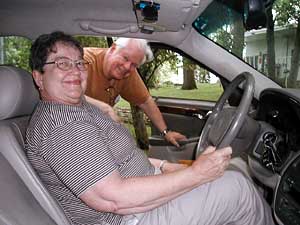July 10, 2005
 |
| Gail and Vern Kenney say they have come to rely on crash avoidance technology and it will be a deciding factor when they buy a new vehicle (MPR photo/Dan Olson) |
St. Paul, Minn. — Gail Kenney slides behind the wheel of her Cadillac. Her husband Vern volunteers to be the obstacle behind the car as she backs out of the garage of their suburban St. Paul home. Warning chimes sound inside the car as it approaches Vern.
"It's this noise I can't ignore," Gail says. "There is no way you can ignore that."
Ultrasonic transmitters and receivers in the bumper of Gail Kenney's Cadillac set off the warning chimes. She says sound combined with a set of small flashing lights above the rear window are especially useful in parking lots.
"I'm so happy I bought all those things," Kenney says. "I need the bing-bings to keep me alert."
Warning devices like this are available on expensive domestic and foreign vehicles sold in this country.
University of Michigan Institute of Transportation Studies engineer David LeBlanc says a new batch of crash avoidance devices are starting to find their way to the marketplace.
"For example there's a forward crash warning that observes how fast you are approaching other cars and will warn the driver by perhaps a beep," he says.
The forward crash warning is related to another device called adaptive cruise control. If another vehicle gets between you and the car ahead of you the adaptive cruise control slows your vehicle and then brings you back to speed at a safe following distance.
As many as one-third of this country's roadway fatalities occur when drivers veer off the road and rollover or crash into an object.
Debra Bezzina, an engineer at Visteon, a Michigan company that makes driver assistance devices, says they are working on a device to warn drivers when they are too close to the edge of the road.
"It'll tell you not only are you going out of your lane, you're going off the road, so if there's a parked car on the road it gives you a warning a lot sooner, and the second component is curve overspeed" she says. "(It tells the driver), 'I'm approaching a curve at too fast a speed. I need to slow down.'"
Researchers are also experimenting with crash avoidance devices that literally take control, for example, by braking a vehicle when a crash is imminent, or tugging the steering wheel back the other direction if the driver is drifting outside a lane.
A good deal of the research on driver assisted devices is funded with state and federal taxpayer dollars including work underway at the University of Minnesota.
U of M researchers are studying rural driving conditions because that's where most vehicle fatalities happen. Deaths on rural roadways outnumber urban deaths 2 to 1.
Max Donath, the director of the U of M's Center for Transportation Studies says they're using radar and other detection devices to help drivers at rural intersections better estimate when it's safe to enter the roadway.
"A safe gap for a tractor-trailer is different for a car; is different than for an agriculture vehicle. It's going to be different for an older driver than a younger driver," Donath says.
One of the most far reaching ideas to help reduce vehicle injuries and fatalities, Donath says, is a digital map of every mile of America's three million miles of rural roadway, a total of six million miles for both lanes. He says the map can be linked with a vehicle's a ground positioning system or GPS. The system would warn the driver if he's getting too close to the edge of the road. Donath says the mapping cost, about $100 million, needs to be compared with other transportation expenses.
"The Oakland Bay (California) bridge is being rebuilt right now to the tune of $6 billion. What is $100 million in the grand scheme of things if it will save maybe 5000, perhaps 10,000 lives a year?" he says.
Crash avoidance technology is increasingly common on this country's fleet of long haul trucks.
Experts say its use in cars depends on consumer demand and automakers willingness to adopt the technology.






